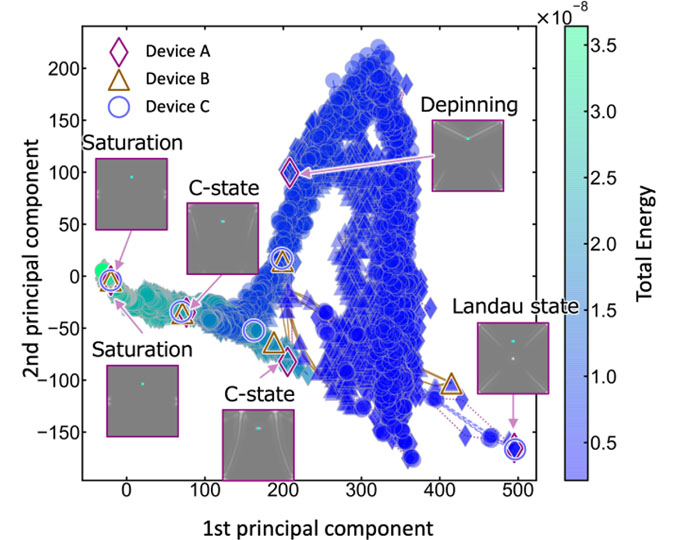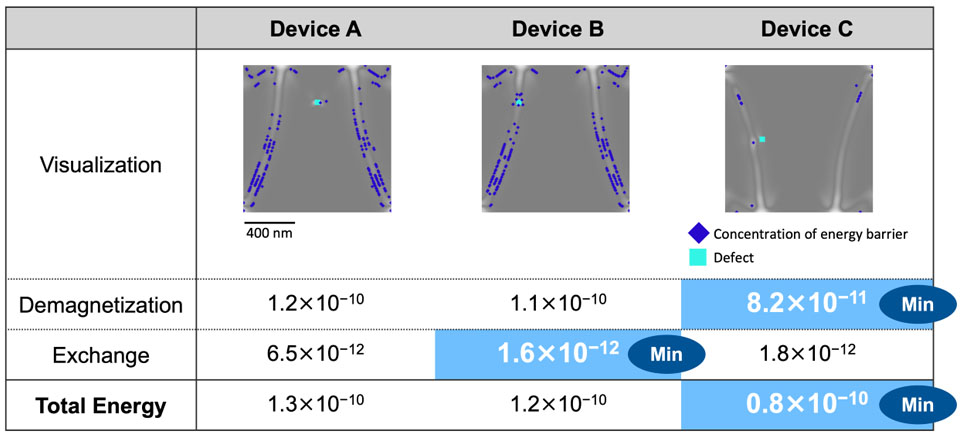| Nov 29, 2022 |
Scientists combine topology and AI with free energy to automate the interpretation of nanomagnetic device microscopy
(Nanowerk News) Microscopic image data is key to developing low-power, high-speed electronic devices. However, the complex interactions in nanoscale magnetic materials are difficult to understand. A research group from Japan realized a new functional design theory called "extended Landau free energy model" that combines topology and artificial intelligence (AI) with free energy to automate the interpretation of the microscopic image. This model illustrates the physical mechanism and critical location of magnetization reversal and proposes a device structure with low energy consumption.
|
|
Microscopic materials analysis is essential to achieve desirable performance in next-generation nanoelectronic devices, such as low power consumption and high speeds. However, the magnetic materials involved in such devices often exhibit incredibly complex interactions between nanostructures and magnetic domains. This, in turn, makes functional design challenging.
|
|
Traditionally, researchers have performed a visual analysis of the microscopic image data. However, this often makes the interpretation of such data qualitative and highly subjective. What is lacking is a causal analysis of the mechanisms underlying the complex interactions in nanoscale magnetic materials.
|
|
In a recent breakthrough published in Scientific Reports ("Causal Analysis and Visualization of Magnetization Reversal using Feature Extended Landau Free Energy"), a team of researchers led by Prof. Masato Kotsugi from Tokyo University of Science, Japan succeeded in automating the interpretation of the microscopic image data. This was achieved using an "extended Landau free energy model" that the team developed using a combination of topology, data science, and free energy.
|
|
The model could illustrate the physical mechanism as well as the critical location of the magnetic effect, and proposed an optimal structure for a nano device. The model used physics-based features to draw energy landscapes in the information space, which could be applied to understand the complex interactions at the nanoscales in a wide variety of materials.
|
 |
| Extended Landau Free Energy Model. Scatterplot of the dimensionality reduction results of principle component analysis. Color represents the total energy. The relationship between magnetic domain and total energy is connected in the explainable feature space. (Image: Masato Kotsugi, Tokyo University of Science)
|
|
"Conventional analysis are based on a visual inspection of microscope images, and the relationships with the material function are expressed only qualitatively, which is a major bottleneck for material design. Our extended Landau free energy model enables us to identify the physical origin and location of the complex phenomena within these materials. This approach overcomes the explainability problem faced by deep learning, which, in a way, amounts to reinventing new physical laws," Prof. Kotsugi explains.
|
|
When designing the model, the team made use of the state-of-art technique in the fields of topology and data science to extend the Landau free energy model. This led to a model that enabled a causal analysis of the magnetization reversal in nanomagnets. The team then carried out an automated identification of the physical origin and visualization of the original magnetic domain images.
|
 |
| Results of causal analysis and visualization. Scientists from TUS have succeeded in visualizing slight changes in microscopic images and understanding the mechanisms that have been difficult to analyze visually. Furthermore, they have succeeded in inverse designing nanostructures with low energy consumption. (Image: Masato Kotsugi, Tokyo University of Science)
|
|
Their results indicated that the demagnetization energy near a defect gives rise to a magnetic effect, which is responsible for the "pinning phenomenon." Further, the team could visualize the spatial concentration of energy barriers, a feat that had not been achieved until now. Finally, the team proposed a topologically inverse design of recording devices and nanostructures with low power consumption.
|
|
The model proposed in this study is expected to contribute to a wide range of applications in the development of spintronic devices, quantum information technology, and Web3.
|
|
"Our proposed model opens up new possibilities for optimization of magnetic properties for material engineering. The extended method will finally allow us to clarify 'why' and 'where' the function of a material is expressed. The analysis of material functions, which used to rely on visual inspection, can now be quantified to make precise functional design possible," concludes an optimistic Prof. Kotsugi.
|


